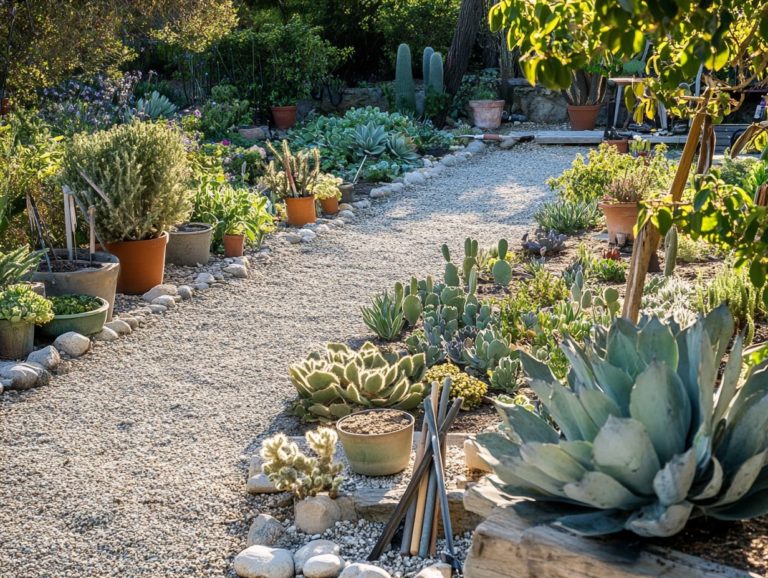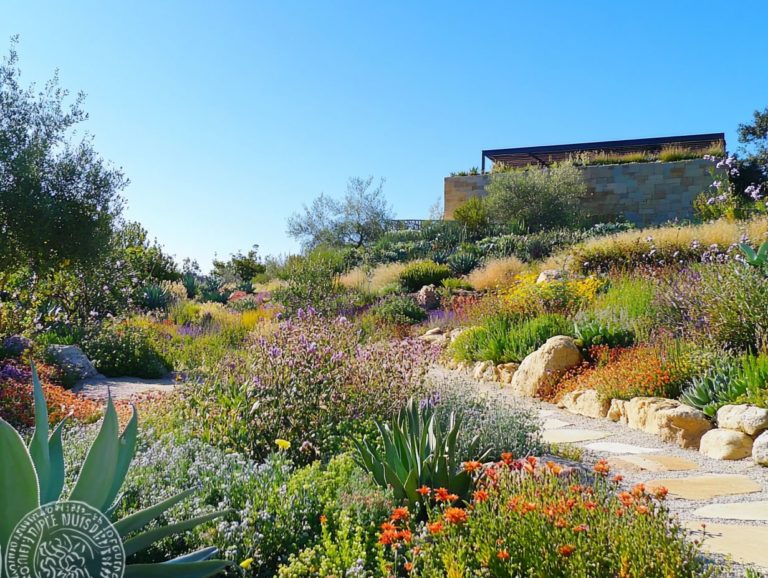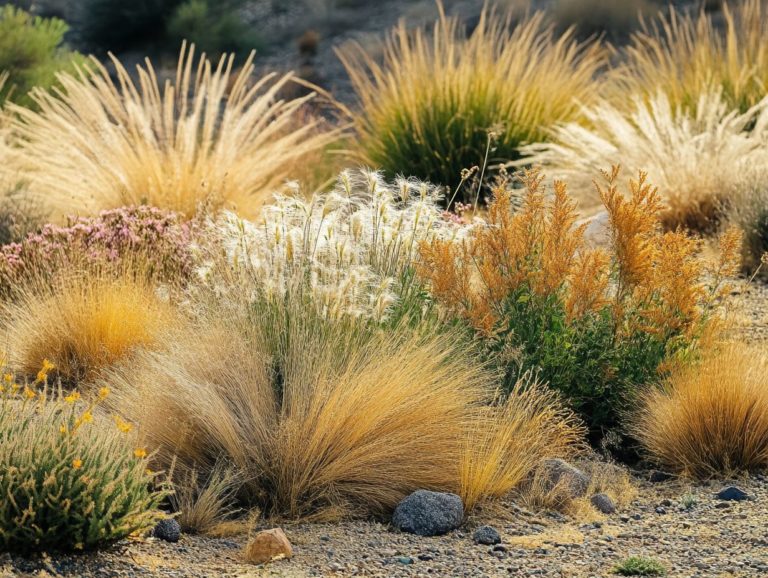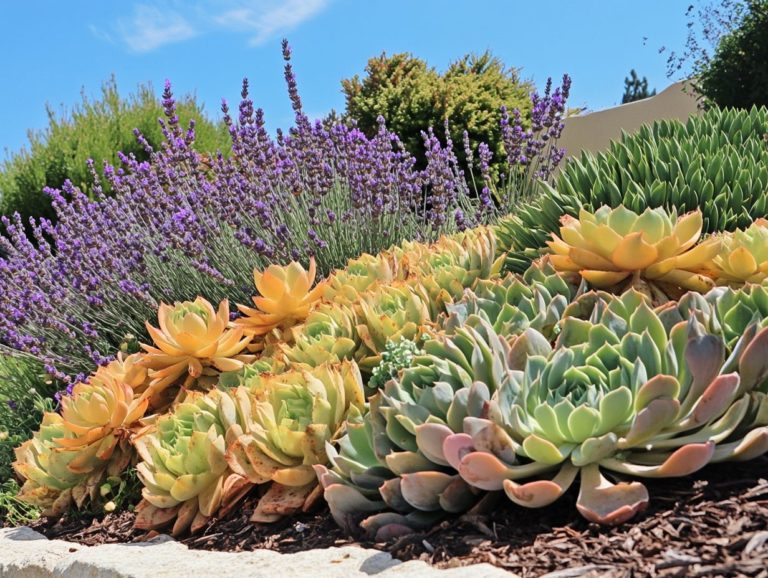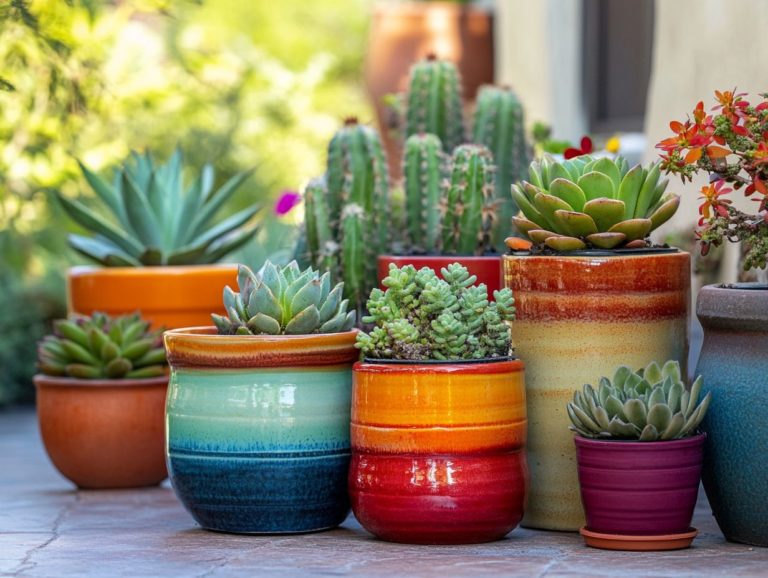Why Choose Drought-Resistant Plants?
In a world increasingly challenged by climate change and water scarcity, understanding drought-resistant plants is crucial for you now more than ever. These resilient species flourish in arid conditions, providing a multitude of environmental and financial benefits that you won t want to overlook.
This article will help you distinguish between native and non-native options while mastering the art of garden design with these hardy plants. We ll also tackle common misconceptions, empowering you to make confident, sustainable choices for your garden. Dive in to discover how you can cultivate a vibrant landscape while conserving water and contributing to the health of our planet!
Contents
- Key Takeaways:
- Understanding Drought-Resistant Plants
- Benefits of Choosing Drought-Resistant Plants
- Types of Drought-Resistant Plants
- How to Incorporate Drought-Resistant Plants in Your Garden
- Maintaining Drought-Resistant Plants
- Common Misconceptions about Drought-Resistant Plants
- Frequently Asked Questions
Key Takeaways:
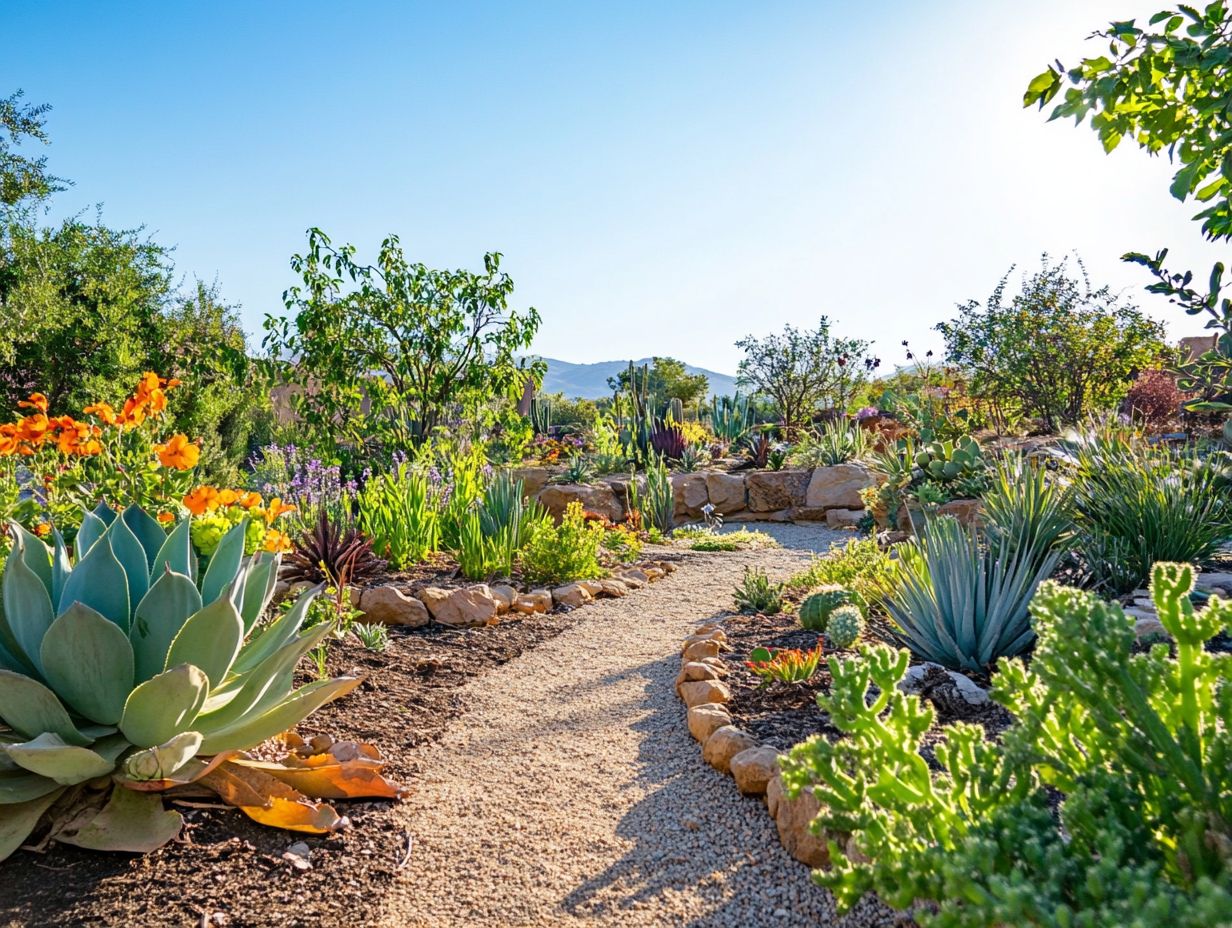
- Choosing drought-resistant plants can provide both environmental and financial benefits, as they require less water and maintenance in the long run.
- Native species of drought-resistant plants are better suited for specific regions and can thrive with minimal care.
- Incorporating drought-resistant plants in your garden can be aesthetically pleasing and can help conserve water resources.
Understanding Drought-Resistant Plants
Understanding drought-resistant plants is essential for elevating your gardening practices, particularly in regions like Southern California, where arid conditions are the norm and climate change poses ongoing challenges to water availability.
These remarkable plants, often called drought-tolerant or drought-resistant, have evolved to thrive with minimal water. They exhibit unique characteristics, such as deep root systems and remarkable resilience to harsh environments. By incorporating these plants into your garden, you contribute significantly to water conservation and sustainable gardening, minimizing the need for excessive irrigation while enhancing soil health.
Definition and Characteristics
Drought-resistant plants, or plants that need little water, are remarkable species that have evolved to flourish in low-water environments. They come equipped with a variety of unique adaptations that help them survive, such as deep-root systems and impressive moisture retention abilities.
These plants typically boast extensive root networks that delve deep into the soil, tapping into water sources that remain out of reach for other flora. For instance, the desert sage has developed thick, waxy leaves that significantly reduce transpiration, effectively minimizing water loss. Similarly, the agave features fleshy tissues designed to store moisture, serving as natural reservoirs during dry spells.
They utilize clever strategies, such as stomatal regulation, a process that helps plants save water by closing tiny openings during peak heat to curb evaporation. Together, these features enable individual species to thrive in harsh conditions while playing a crucial role in maintaining ecological balance providing food and habitat for various organisms within their ecosystems.
Benefits of Choosing Drought-Resistant Plants
Opting for drought-resistant plants offers you a wealth of advantages, especially regarding water conservation and significant savings on your water bills. This makes them an excellent choice for sustainable gardening practices.
These resilient plants require less upkeep, enabling you to cultivate a low-maintenance garden that flourishes even in the face of drought conditions.
Start your journey today by visiting a local nursery that specializes in drought-resistant plants or planning your own garden project!
Environmental and Financial Advantages
The environmental and financial benefits of incorporating drought-tolerant plants into your landscaping are truly remarkable. They substantially cut down on water usage and can lead to noticeable savings on your water bills over time.
These resilient plants play a vital role in enhancing biodiversity by providing habitats for various species, enriching local ecosystems. For example, native drought-tolerant perennials often attract essential pollinators like bees and butterflies, critical for maintaining plant diversity and supporting agricultural productivity.
The deep root systems of these plants combat erosion effectively, helping to stabilize soil, especially on sloped terrains. A study by the Environmental Protection Agency reveals that homeowners can save more than 30% on irrigation costs by choosing the right drought-tolerant options making sustainability not just a responsible choice but also an economically savvy one.
Types of Drought-Resistant Plants
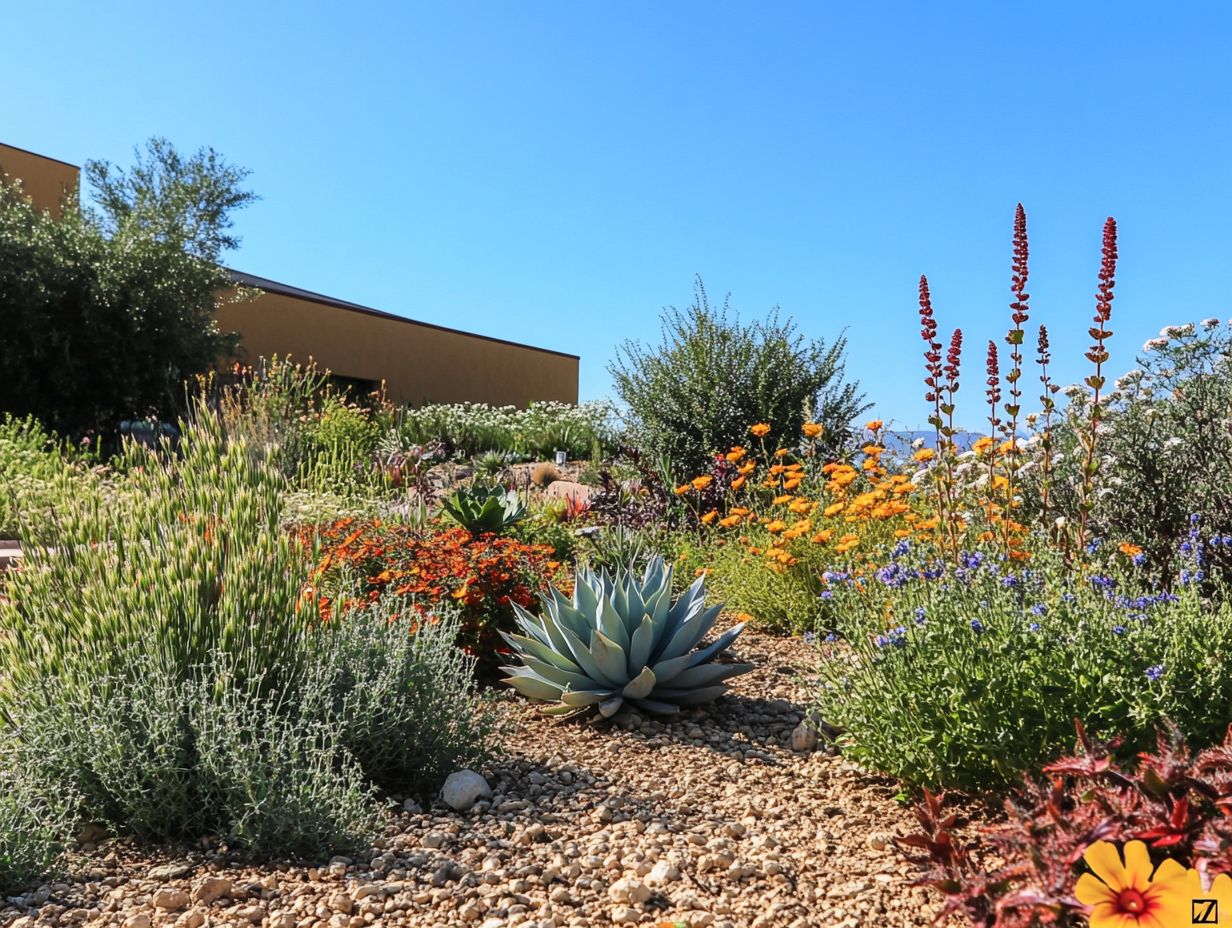
You have a wealth of options when it comes to drought-resistant plants. Consider native species that have elegantly adapted to your local arid conditions, or robust xerophytes plants that thrive in dry conditions that flourish with minimal water.
Incorporate native plants like Acacia and Agave into your garden; they elevate the visual charm of your landscape and support local wildlife.
These choices are perfect for creating stunning, sustainable gardens that can serve as the perfect backdrop for flower-themed parties.
Native vs. Non-Native Species
Choosing between native and non-native drought-resistant plants is essential for crafting a truly drought-tolerant garden. Native plants typically adapt better to local climates, support local wildlife, and demand less water and maintenance.
Non-native species can infuse your garden with vibrant aesthetics and unique features that enhance its visual appeal. However, integrating these plants can disrupt existing ecosystems, as they may not mesh well with local pollinators and wildlife.
Understanding the roles these plants play in the environment is vital. Native species cultivate symbiotic relationships with bees, butterflies, and other pollinators, making them critical for maintaining local biodiversity. While non-native options may initially thrive, their long-term impact could jeopardize the health of native flora and fauna, ultimately compromising the sustainability of your garden.
How to Incorporate Drought-Resistant Plants in Your Garden
Incorporating drought-resistant plants into your garden requires a meticulous approach to design, a keen selection of plants, and smart watering choices that enhance moisture retention while minimizing irrigation requirements.
Design Tips and Plant Selection
When selecting plants and designing your drought-tolerant garden, consider factors like soil condition, moisture retention, and the choice of heat-resistant plants that can thrive in your specific climate.
Plan your plant placements to create a vibrant and inviting garden! Group plants with similar watering needs to promote efficient irrigation. A harmonious color scheme can transform your landscape into a visual delight, with vibrant succulents like Agave or Sedum adding stunning focal points.
Incorporating unique textures through ornamental grasses, such as Blue Oat Grass, not only enhances the garden’s depth but also keeps maintenance to a minimum. Opt for resilient species like Lavender or California Poppy to beautify your space while standing strong in arid conditions, making them ideal for drought-prone areas.
By understanding these elements, you can create a garden that is both sustainable and aesthetically pleasing.
Maintaining Drought-Resistant Plants
To maintain drought-resistant plants effectively, grasp the nuances of proper watering techniques. Embrace deep watering practices and incorporate organic materials to enrich soil health.
This approach empowers your plants to thrive even in challenging, low-water conditions.
Watering and Care Techniques
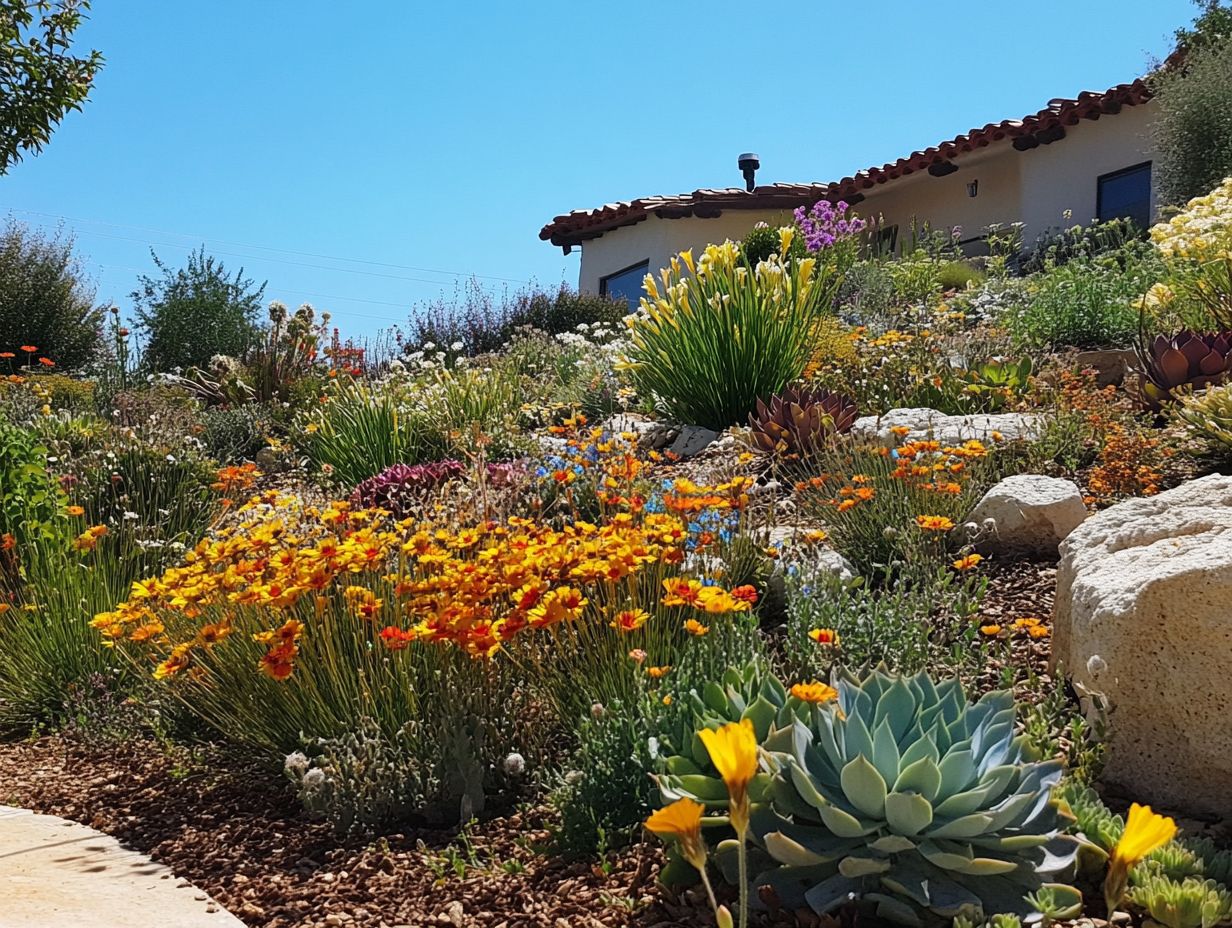
Effective watering and care techniques, like using drip irrigation systems or automatic sprinklers, can enhance moisture retention and optimize water usage in your drought-tolerant garden.
These advanced methods allow for precise water application, ensuring your plants receive exactly what they need. This reduces wastage and encourages deep root growth. Unlike traditional overhead sprinklers that can cause surface runoff and evaporation, modern irrigation solutions deliver water directly to the soil. This makes them especially beneficial for drought-resistant plants.
You can program these systems to operate during cooler hours, minimizing water loss. By adjusting your watering schedule based on weather conditions or soil moisture levels, you cultivate an environment that fosters the robust growth of drought-resistant plants and promotes overall garden health.
This approach helps create a sustainable and thriving ecosystem that you can be proud of.
Common Misconceptions about Drought-Resistant Plants
Misconceptions about drought-resistant plants can create confusion around their care. Myths often suggest that these plants require little to no water or attention.
However, understanding their specific needs is essential for cultivating a truly low-maintenance garden. Knowing what each plant requires sets you on the path to success.
Debunking Myths and Clarifying Facts
Debunking myths and clarifying facts about drought-tolerant plants can elevate their appeal while promoting environmental responsibility. These plants are not just sustainable; they also provide remarkable opportunities for your garden.
You might think that drought-tolerant varieties lack beauty or diversity, but the truth is far more enchanting. These plants come in a dazzling array of colors, shapes, and sizes, making them ideal for crafting vibrant and dynamic landscapes.
Incorporating them into your garden allows you to significantly reduce water consumption and embrace more sustainable gardening practices. Choosing varieties that thrive in arid conditions helps support local ecosystems, enhance biodiversity, and minimize the need for chemical fertilizers and pesticides.
Ultimately, adopting drought-tolerant plants fosters responsible environmental stewardship and builds resilience against climate change.
Frequently Asked Questions
What are drought-resistant plants?
Drought-resistant plants are specially adapted to thrive with minimal water. They re perfect for dry gardens!
Why choose drought-resistant plants?
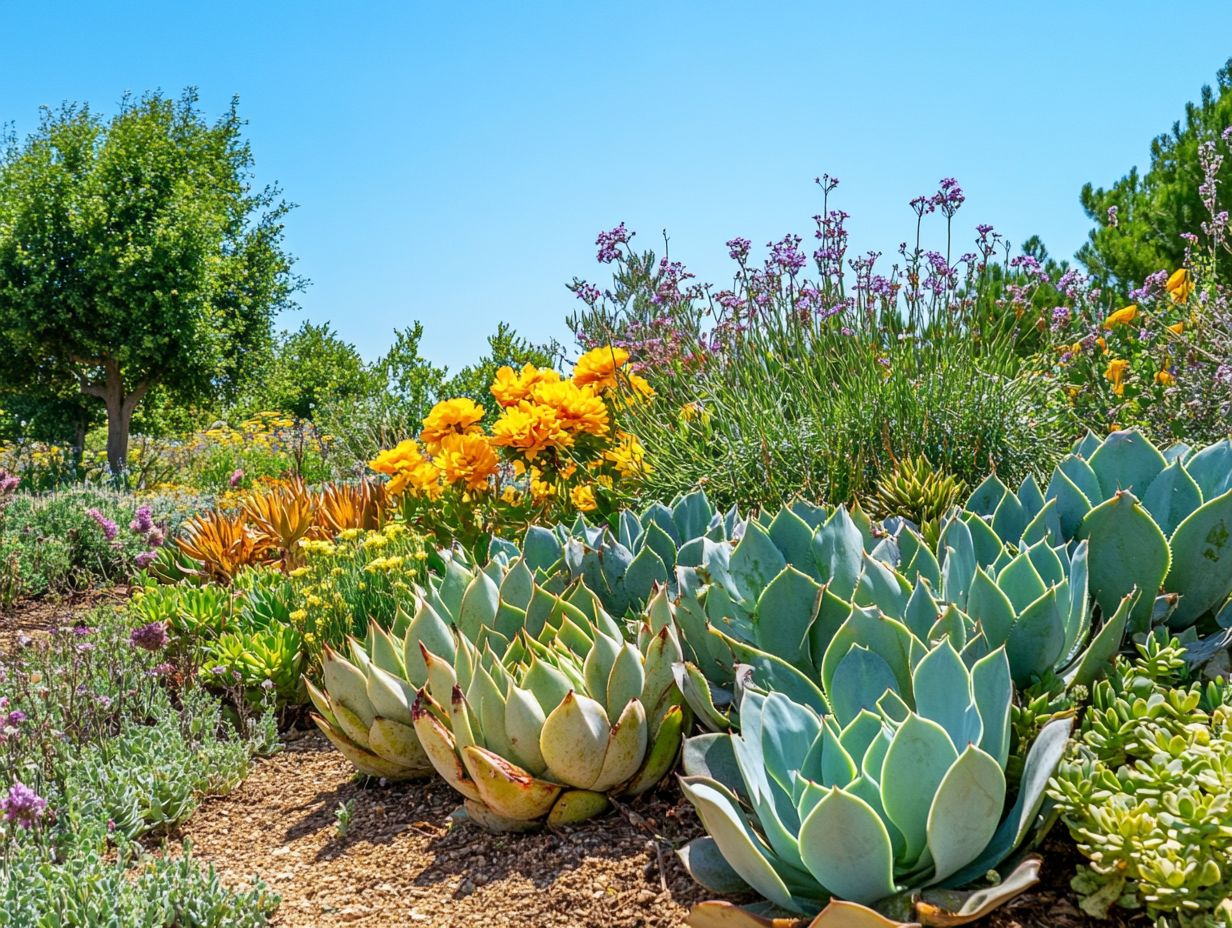
Discover why drought-resistant plants are essential today for your garden! They require less water, leading to lower water bills and reduced environmental impact. They also need less maintenance, making them ideal for busy gardeners. Furthermore, they are more resilient and can withstand extreme weather better than traditional plants. Start choosing drought-resistant plants today to save water and enhance your garden!
What are some examples of drought-resistant plants?
Many types of drought-resistant plants exist, including succulents, cacti, lavender, sage, and yarrow. Other options include ornamental grasses, sedums, and agaves. It’s important to choose native plants for the best chance of success.
How do I care for drought-resistant plants?
Drought-resistant plants are low-maintenance but still need some care. Once established, they typically only require watering once or twice a month. Good drainage is crucial, and overwatering should be avoided. Pruning and fertilizing needs vary by plant type, so it’s wise to do some research or consult with a local gardener for specific care instructions.
Can I still have a beautiful garden with drought-resistant plants?
Absolutely! Drought-resistant plants can be just as stunning and colorful as traditional varieties.
You can create a lush garden with many options available. They are low-maintenance and environmentally friendly, making them a fantastic choice.
Where can I purchase drought-resistant plants?
You can find drought-resistant plants at most nurseries and garden centers.
Purchase them online from trusted retailers to ensure quality. Always check that the plants suit your local climate and conditions.

